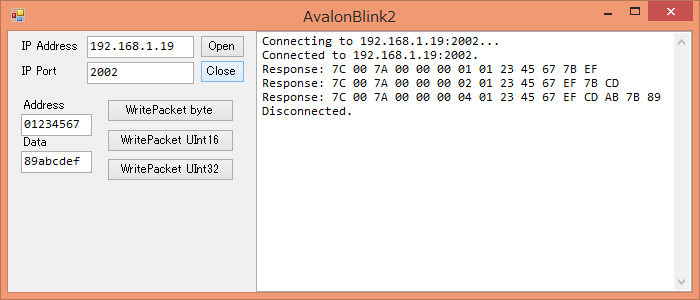EP2C5T144+ESP-32(3)Wifiスケッチ
前回に続き作業手順の1番目、WindowsアプリとESP-WROOM-32スケッチをWifiで接続します。
- Windows PC上でFPGAを操作するためのバイト列を作ってWifiで送信
- ESP-WROOM-32で受信したバイト列をSPIでFPGAに送信
- FPGAで受信したバイト列をデコードしてボード上のLEDを点滅
Windows PC →(Wifi)→ ESP-WROOM-32 →(SPI)→ EP2C5T144の内、Wifiの部分を実装します。
まずはESP-WROOM-32側のArduinoスケッチです。
#include <WiFi.h>
/* Set these to your desired credentials. */
//const char *ssid = "ESPap";
//const char *password = "thereisnospoon";
const char* ssid = "your-ssid";
const char* password = "your-password";
WiFiServer server(2002);
WiFiClient client;
#define PACKET_BUF_LEN 1024
byte packetBuf[PACKET_BUF_LEN];
void setup() {
Serial.begin(57600);
// Serial.println();
// Serial.print("Configuring access point...");
// /* You can remove the password parameter if you want the AP to be open. */
// WiFi.mode(WIFI_AP);
// WiFi.softAP(ssid, password);
// IPAddress myIP = WiFi.softAPIP();
// Serial.print("AP IP address: ");
// Serial.println(myIP);
Serial.println();
Serial.print("Connecting to ");
Serial.println(ssid);
//WiFi.mode(WIFI_STA); // Disable Access Point
WiFi.begin(ssid, password);
while (WiFi.status() != WL_CONNECTED) {
delay(500);
Serial.print(".");
}
Serial.println("");
Serial.println("WiFi connected");
Serial.println("IP address: ");
Serial.println(WiFi.localIP());
server.begin();
Serial.println("Server started");
}
void loop() {
if (!client.connected()) {
// try to connect to a new client
client = server.available();
} else {
// read data from the connected client
int n = client.available();
if (n > 0) {
//Serial.print("available: ");
//Serial.println(n);
if (n > PACKET_BUF_LEN) {
n = PACKET_BUF_LEN;
}
// loopback
client.readBytes(packetBuf, n);
client.write(packetBuf, n);
}
}
}
ソケット通信機能を追加した動作確認用のWindowsアプリの画面です。ESP-WROOM-32は受信したバイト列をそのまま返し、アプリはそれを表示しています。
